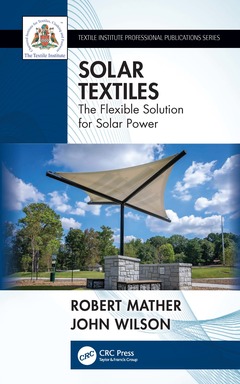Solar Textiles The Flexible Solution for Solar Power Textile Institute Professional Publications Series
Auteurs : Mather Robert, Wilson John

Most photovoltaic (PV) installations utilise heavy conventional glass or polycarbonate panels, and even newly developed thin plastic or metal films for PV cell use may fracture during both construction and application. Textile fabrics, the most widespread flexible materials in everyday use, offer a solution to the need for lightweight, flexible solar PV generators. Solar Textiles: The Flexible Solution for Solar Power is about the incorporation and operation of solar cells on textile fabrics. The combination of textile manufacturing and solar PV cell technology opens up further avenues for both the textile and semiconductor industries. Thus, this book reflects the progressively increasing commercial interest in PV cell technology and the versatility that their integration in textiles provides.
- Discusses textiles as electrical substrates
- Explains the photovoltaic effect and associated parameters
- Offers special consideration of solar cells on textiles
- Compares fibres and fabrics and how to implement PV activity on a textile
- Describes manufacturing methods outside of semiconductor technology
- Includes applications open only to textiles
This work is aimed at textile technologists, electronic engineers, solar technologists, civil engineers and designers in building fabrics and architecture.
1. The Versatility of Textile Fabrics, 2. The Photovoltaic Effect and How It Is Used, 3. Constructions of Textile Fabrics, 4. Strategies for Achieving Electrically Conducting Textile Fabrics, 5. Enabling Textile Fabrics to Become Photovoltaically Active, 6. Technological and Design Specifications, 7. Manufacturing: Moving from Laboratory to Production, 8. Applications of Solar Textile Fabrics, 9. The Outlook for Solar Textiles
Robert Mather’s involvement with textiles began when he joined the staff at the Scottish College of Textiles (SCOT) in Galashiels in 1983. He had previously worked for ten years at Ciba-Geigy Pigments in Paisley, following two spells of postdoctoral work at Imperial College and Brunel University in London. At SCOT, which subsequently became part of Heriot-Watt University, Robert acquired his interest in technical textiles and established a profile in the processing of polypropylene fibres. He also worked on three-dimensional woven engineering products.
His current R&D interests include the incorporation of solar cells on textiles, and Power Textiles Limited was formed in 2012 with John Wilson as co-Director to promote solar textiles. Robert also has an interest in gas plasma treatments for textiles. He was Director for five years of the newly established Technical Textiles and Polymer Innovation Unit at Galashiels, set up with funds from the UK Department of Trade and Industry. During this period, the Unit successfully undertook projects for a variety of companies, and Robert was contracted to write on the technical textile industry in Scotland for a briefing paper for the Scottish Executive. The Unit was eventually subsumed into the UK TechniTex Faraday Partnership, and he became responsible for technology transfer in the Partnership’s organisation. He has also been Director of the Biomedical Textiles Research Centre at Heriot-Watt University.
He is the author of over 90 technical papers and in recent years has contributed chapters to a number of books on technical textiles. Together with a co-author, he wrote a book on textile chemistry for the Royal Society of Chemistry in 2011. A second, updated edition was published in 2015, and a third edition is currently in preparation.
Professional memberships held include:
- Fellow of the Royal Society of Chemistry, CChem
- Fellow of the Textile Institute, CTex
Date de parution : 11-2022
15.6x23.4 cm
Date de parution : 11-2022
15.6x23.4 cm
Thèmes de Solar Textiles :
Mots-clés :
photovoltaic Cells; industrial textiles; fabric solar cell; wearable solar cell; PV cells; flexible solar cells; Solar Cells; PV Cell; Textile Fabrics; PV Textile; Solar Textile; Organic PV; PV Device; Solid State Dye Sensitized Solar Cells; Hole Transport Layer; PV Array; Solar Simulator Lamps; SEM; Perovskite Solar Cells; Conducting Yarns; Luminescent Solar Concentrator; Conventional Yarn; DSSC; Conductive Polymer; Li Ion Battery; Energy Densities; Twill Weave Structure; Weft Yarns; Non-woven Fabrics; Weave Structures



